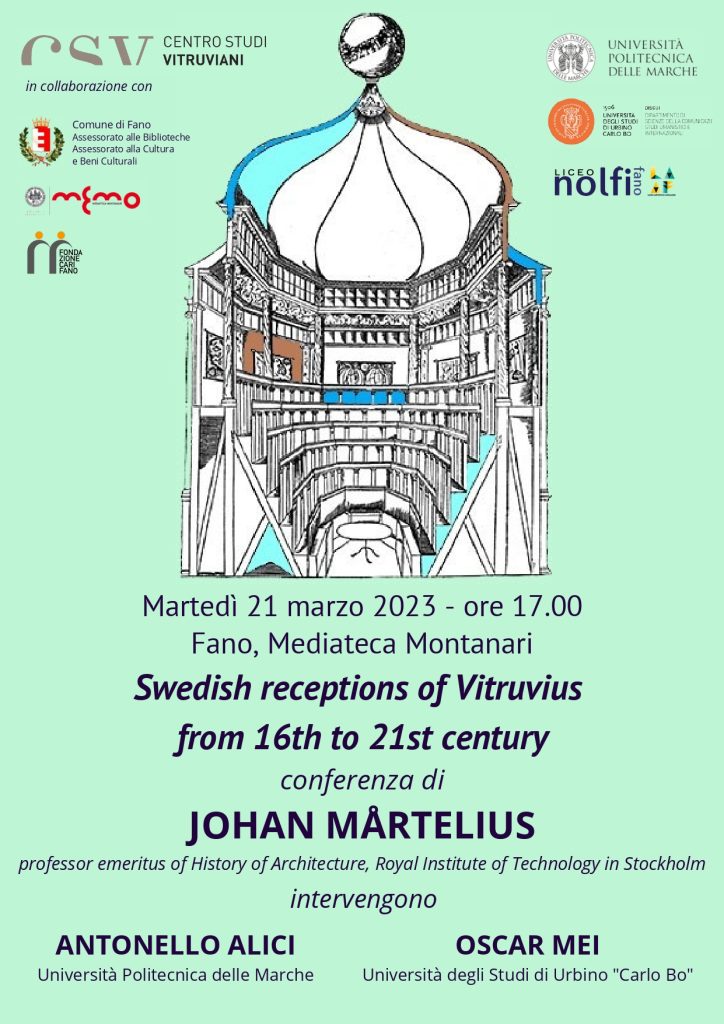Swedish receptions of Vitruvius from 16th to 21st century
Fortuna di Vitruvio in Svezia dal XVI al XXI secolo
Lecture by Professor Johan Mårtelius
Martedì 21 marzo 2023 ore 17.00 presso Mediateca Montanari, Fano – free entrance
Il Centro Studi Vitruviani, in collaborazione con Università Politecnica delle Marche, Università degli Studi di Urbino Carlo Bo, Liceo Nolfi di Fano e con il patrocinio del Comune di Fano, assessorati alle Biblioteche e alla Cultura e Beni Culturali, e della Fondazione CariFano, organizza per martedì 21 marzo 2023, a Fano, Mediateca Montanari, ore 17.00, una conferenza del prof. Johan Mårtelius, professore emerito di Storia dell’Architettura presso il Royal Institute of Technology di Stoccolma.
Si tratta di una iniziativa che anticipa una giornata di studi che il Centro Studi Vitruviani ha in programma nel mese di ottobre prossimo, quando a parlare degli influssi di Vitruvio nei paesi nordici verranno a Fano studiosi dalla Svezia, Finlandia, Norvegia e Danimarca.
Intanto martedì 21 marzo il prof. Johan Mårtelius ci parlerà della diffusione del De Architectura di Vitruvio in Svezia, a partire dal XVI secolo, e degli influssi diretti dei principi vitruviani su importanti architetture di noti architetti svedesi, come, ad esempio, il teatro di Uppsala di Olof Rudbeckoppure il Museo Nordiska di Stoccolma che l’arch. Isak Gustaf Clason realizzò ispirandosi direttamente alla Basilica vitruviana di Fano (tema molto presente in questi giorni).
Il prof. Mårtelius, autore fra l’altro di una traduzione in svedese del De Architectura, sarà introdotto dal prof. Antonello Alici, Politecnica delle Marche, e dal prof. Oscar Mei, Università di Urbino Carlo Bo, direttore scientifico del Centro Studi Vitruviani.
L’evento potrà essere seguito anche da remoto, sul canale YouTube del Centro Studi Vitruviani.
–
About…
An early reference to Vitruvius in a Swedish context is for the king Erik XIV, who ruled 1560-68. His education in fortification and architecture included studies of his own copy of Vitruvius, although its outcome in royal building projects can not be determined.
The first obvious result from Vitruvius is from a century later, when the widely learned scholar Olof Rudbeck designed the anatomical theater in Uppsala. The space, still crowning the university building from a generation earlier, is octagonal and framed in steps formed by the five Vitruvian orders. The relation of the orders to the human body, placed in the centre, can be considered as the fundamental concept.
A more widely active relation to Vitruvius was established by the royal architects Nicodemus Tessin the elder and the younger, especially the son (1654-1728) who owned several versions of the Libri Dieci. In the 18th century studies of Vitruvius became more widespread, reflected both in architectural practice and in writings.
In the 19th century Vitruvian studies were shadowed by other authorities, but some more specific cases can be found. One such case is the influential museum building, Nordiska museet in Stockholm, designed in the 1880s and 90s and completed in 1907. The museum, formed as a large hall with galleries, was considered more as a social public space than as a frame for museal objects, and one source of inspiration for its architect Isak Gustaf Clason was obviously the basilica in Fano. The version most closely reflected was the one published by Clason’s major authority, Viollet-le-Duc, in the Entretiens sur l’architecture (1863), controversially presenting Vitruvius as an inventive, non-conventional architect.
In the movement for Swedish or Nordic classicism, mainly in the 1920s, Vitruvius gained new importance, but whereas the four books by Palladio were then translated into Swedish (1928), the ten books by Vitruvius were not translated until the next phase of active interest in the classical tradition. The translation published in 1989 was based on a few translations into English and German, so not produced for latin scholars but for architects, as also emphasized by the selection of illustration from 16th century versions as well as in its introduction. A paperback version of the translation was published in 2009, making it more widespread in architectural education and daily practice.
–
Johan Mårtelius, Architect and PhD, professor emeritus in History of architecture at KTH Royal Institute of Technology, Stockholm (1993-2019). His interests in antiquity and the classical tradition have resulted in a number of publications on both the Mediterranean and the Nordic regions. These include the Swedish translation of Vitruvius (1989, 2nd edition 2009), where he was advisor and writer of introduction and notes and made the selection of illustrations. A number of essays regarding Vitruvius and the Vitruvian tradition have been published in English and Swedish. These include studies on the Swedish architects Nicodemus Tessin the Younger (1654-1728) and Carl Hårleman (1700-1753) and also on the Swedish classicist movement of the 1920s, often named Swedish Grace.
Informazioni
01/03/2023 alle 12:00
